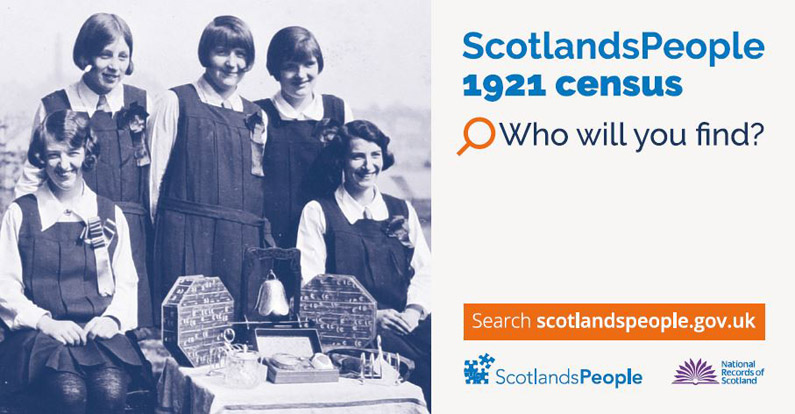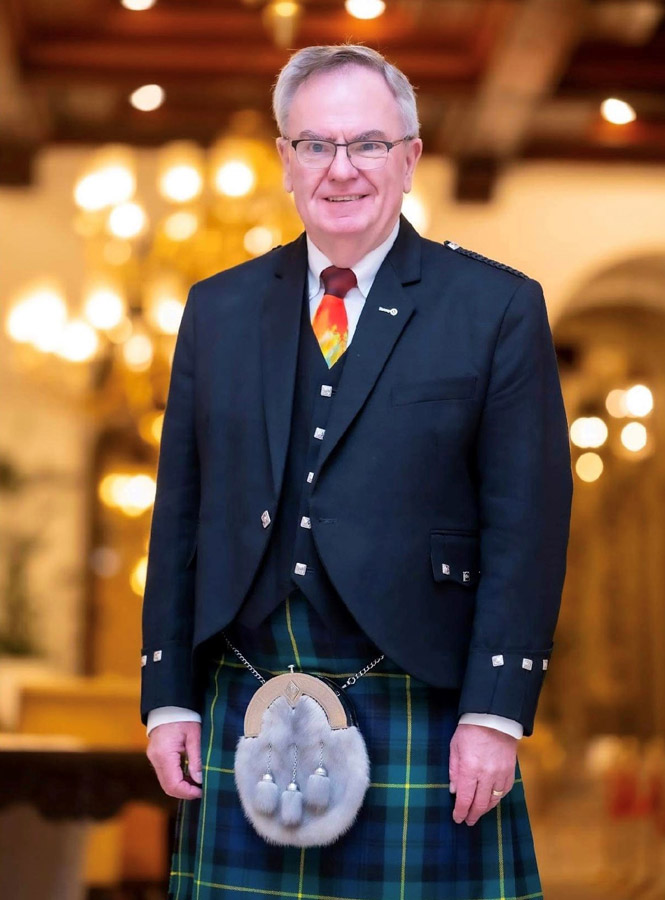If you are Scottish by heritage you may be interested to learn that to coincide with St Andrew’s Day, ScotlandsPeople has just released the 1921 Scottish census records for the first time, comprising 200,000 images recording the details of 4.8 million people.
Recorded on the night of 19 July 1921, the census details accommodation, residents’ relationships to each other, their ages and occupations, and for the first time, information on orphanhood, dependent children and workplace. It reflects the societal changes in Scotland in the aftermath of the Great War as well as the Great Influenza Pandemic.
ScotlandsPeople shared with us some key facts and figures about Scotland in 1921 as well as information about some interesting finds they have discovered in the census records. While statistical information has long been known this is the first time personal data has been seen.
Facts from the 1921 Census Report
| 1921 | Most Recent Comparisons |
| Population 4.8 million | Population 5.4 million (12% increase) |
| Median age 29.6 years (half older and half younger) | Median age 42.2 years |
| 3.4% aged over 70 | 14% aged over 70 |
| 77.3% were living in urban areas | 82.5% were living in urban areas |
| 99.5% born in the UK | 90% born in the UK |
| 3.47% of people aged 3 and over could speak Gaelic | 1.7% of people aged 3 and over could speak Gaelic |
| 8% of households in a one room home (12% in Glasgow) | 0.6% of households live in a one bedroom home (1.5% in Glasgow) |
1921 Background Information
War fatalities left a big gap in Scotland’s population. In 1921 there were 187,213 more females than males. That’s 27 females for every 25 males but it affected younger ages more due to the disproportionate number of younger men who died in the war. There were 19% more 25 year old women than men of the same age. The 1921 census report says that some of the gap can also be attributed to earlier emigration out of Scotland. Estimates put Scottish war casualties between 100,000 and 135,000 although some of these men may have emigrated but returned to fight in a Scottish regiment.
Scotland in 1921 was also recovering from the Great Influenza Pandemic, commonly known as the ‘Spanish Flu Pandemic’. A report by the Registrar General showed that between 1918 and 1919 17,575 people died with influenza listed on the death certificate.
The county of Lanark which included Glasgow had grown fast during the industrial revolution. In 1921 it was ten times the size it had been in the 1801 census.
Glasgow itself had more than a fifth of the country’s population at over 1 million people.
Scotland’s housing system was radically different back then. As many as 90% of homes were rented. The 1921 census was the first to record no-one living in a windowless house. This was the era of “homes fit for heroes” and the census found more homes under construction than at any previous census. Scotland’s first post-war social housing project, the Logie Estate in Dundee, had already been put up and the residents are enumerated for the first time in their new homes. It is likely that conditions were a lot better than where they had left but our researchers are still finding large families in modest homes including Norman McLaren, lone parent to a two year old girl following the death of his young wife from influenza, living with his mother and six adult siblings in a three room home on the new estate.
The 1921 census also captured some fun times too. The 1921 Open Golf Tournament at St Andrew’s was not yet in full swing but the town’s hotels were already filling up with famous golfers and their media entourage. The census page for the Links Hotel includes winner John “Jock” Hutchison who was born in St Andrew’s but emigrated to America and played on the USA team. His employer is listed as the Glenview Golf Club just 25 miles from our Chicago Scots headquarters in North Riverside, Illinois.
Delivering the 1921 census
In Scotland the work of delivering the census was led by the Registrar General who relied on a network of registrars and enumerators to get census forms called “schedules” out to every household, filled in and returned. The information from the schedules was then copied into enumeration books by hand. It is images from the pages in those books that customers can find on ScotlandsPeople.
The census of 1921 was taken on 19 June. This meant that on the night of the census some areas popular with tourists had artificially large populations. Concern about strikes in the coal mining industry had led to the army stationing groups of soldiers in collieries and our research has found that part of Denbeath Public School in Methil was a temporary Barracks for 156 soldiers. Among the officers is the Honourable John Dewar who in addition to having a distinguished military career was Director of Public Companies at whisky giant Dewar’s. The 1921 census records reveal that at the Blackrigg colliery number three in West Lothian, a shale mine, a Company of soldiers were ‘protecting the colliery and not living in houses’. These 21 Privates, three Lance Corporals, one Sergeant and one Lieutenant would all appear to be Army Reservists as all their occupations and employers are detailed. We can see an electrician, a box maker, a gardener, and a tailor who worked for O Clark & Co, Thread Mills in Paisley. More mines across the county had soldiers stationed there during 1921 including Cowie Colliery in Fife and Bowhill Colliery Cardenden. The Royal Navy and Royal Marines were also involved with 650 personnel stationed the East Fortune Airfield in East Lothian.
St Kilda’s Lost Community
The 1921 census records 73 people living on St Kilda, mostly crofters and hand loom weavers. The island would be evacuated in 1930 making this the last time an indigenous community participated in a national census. Today there is a military base and owners, The National Trust for Scotland, have staff based there part of the year. You can read more about life on St Kilda in this article on the NRS website
Stories from St Kilda | National Records of Scotland (nrscotland.gov.uk)
Opening the 1921 Census
Making the personal data of a census available is an unusual undertaking in that it unites two teams of people 100 years apart. The Census Act of 1920 ensures that once the statistical information has been created from household data the personal information like names, relationships and ages must be kept confidential for 100 years. Only at that point can it be opened for members of the public to view.
To give people an efficient way of searching, digital copies have been taken of every page of every enumeration book and then every handwritten name transcribed into a computerised index. Quality review work has also been undertaken to improve accuracy.
With a ScotlandsPeople account people can search for their ancestors or other people of interest at no charge with just names and an idea of where they might have been living. There’s a fee to view the images. While there are no guarantees that a person is listed it is likely that they will be included if they lived in Scotland at the time. There are online guides full of hints and tips for users. Using the census is a great opportunity to turn detective and we at the Chicago Scots encourage everyone to explore their ancestry! Who will you find?


 Every year at our Scottish Festival & Highland Games, the Chicago Scots feature a family or an organization as our Honored Clan. This year, to recognize and celebrate its’ strong Scottish roots, our Honored Clan is Rotary International. We are proud to announce that Rotary International’s Scottish President, Gordon McInally has agreed to lead our Parade of Tartans at 12:30 p.m. Gordon will also receive the Salute to the Chieftain from the Massed Pipe Bands at approximately 6.30pm on Saturday, June 15, 2024.
Every year at our Scottish Festival & Highland Games, the Chicago Scots feature a family or an organization as our Honored Clan. This year, to recognize and celebrate its’ strong Scottish roots, our Honored Clan is Rotary International. We are proud to announce that Rotary International’s Scottish President, Gordon McInally has agreed to lead our Parade of Tartans at 12:30 p.m. Gordon will also receive the Salute to the Chieftain from the Massed Pipe Bands at approximately 6.30pm on Saturday, June 15, 2024.